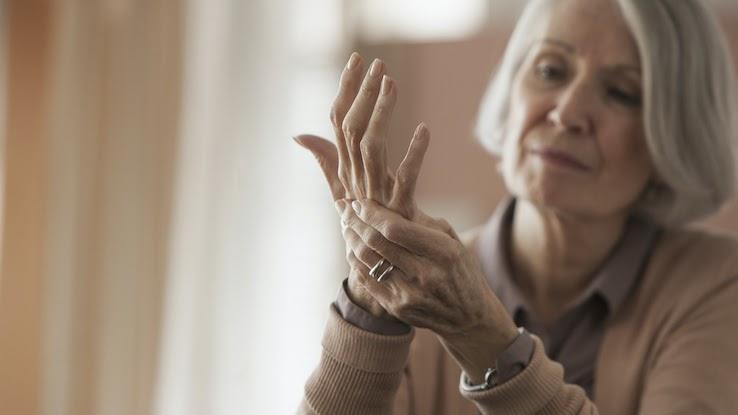How Do You Know How Long Someone Has to Live

Osteoarthritis (OA) is an age-related grade of arthritis. OA is what's known as a degenerative articulation illness, and information technology tends to occur most commonly in the hips, dorsum, hands and feet. In the United states of america, over 32.v 1000000 adults are living with OA, which has no known cure. Still, certain activities tin can reduce your risk of developing OA, and in that location are steps yous can have to salvage the associated discomfort one time you've been diagnosed with this health status.
What Is Osteoarthritis?
OA is a painful joint disease that occurs when the cartilage inside a joint starts to interruption down. Cartilage ordinarily serves equally a shock-arresting cushion between bones, and its breakdown results in bones rubbing directly against one another during movement. This friction causes the bone to thicken, which tin cause spurs (bony growths) to develop between joints.
Stiffness, hurting and loss of motility may occur as the joint lining becomes inflamed afterwards long-term cartilage breakup and spur growth. Over fourth dimension, the abrasions between bones that occur when they rub together may outcome in permanent joint damage.
Symptoms of Osteoarthritis
Symptoms of OA may vary from person to person. However, most people living with this condition tend to feel at least one of the following:
- Joint soreness
- Joint hurting
- Articulation stiffness following periods of inactivity
- Forenoon stiffness that dissipates quickly
- Decreased range of motion
- Changes in posture, walking and actual coordination
- Pain in weight-bearing areas of the body, such every bit the knees, hips, spine and extremities
What Causes Osteoarthritis?
As a person ages, information technology'southward normal for their cartilage to lose its elasticity. However, intensive stress such every bit vigorous do can make the cartilage break downwardly faster and make a person more likely to develop OA.
There are ii types of OA: primary and secondary. Primary OA is known as the more common "wear-and-tear" OA and is commonly associated with crumbling. Secondary OA may happen from a diversity of modifiable run a risk factors, including prior injuries, weight and genetics.
While the specific cause of OA is still unknown, there are several factors that can increase your risk of developing this condition:
- Weight: Individuals with obesity are at an increased risk of developing OA, every bit their joints may experience stress due to increased weight-bearing.
- Age: OA is known as the "article of clothing-and-tear" course of arthritis and is associated with increasing age.
- Anatomical sexual activity at nascence: OA affects people assigned female at nascency more than those assigned male at birth, particularly later the age of 50.
- Genetic predisposition: OA often runs in families. In addition, an individual with arthritis in one area of their body is at an increased risk of developing OA in another surface area, such as their knees or hands.
- By injury or joint overuse: Prior sports or occupational injuries (such as physical labor, repetitive motion or frequent heavy lifting) can contribute to the development of secondary OA.
- Having other illnesses and deficiencies: People with other forms of arthritis take a greater chance of developing the condition. In addition, deficiencies in certain hormones and vitamins C, D and E may also play a role in the development of OA.
Diagnosis & Testing for Osteoarthritis
To diagnose OA, your doctor volition first take a thorough medical and social history in order to build a complete picture of your condition. Included in this medical history will be a review of your past and present symptoms.
Side by side, your physician will perform a concrete exam to check your joints for swelling, abnormal growths and changes in range of move. Post-obit the physical examination, you will likely undergo imaging, such every bit an X-ray or magnetic resonance imaging (MRI). Depending on the results of your imaging, your physician tin recommend a treatment protocol and activity adjustments.
Treating Osteoarthritis
In that location are no known cures for OA, merely in that location are steps yous can have to prevent or alleviate the symptoms you experience:
- Weight control: For individuals with obesity, weight control may be the best self-management technique to alleviate OA symptoms. Losing weight will help alleviate additional stress on the joints.
- Physical activity: Moderate exercise can strengthen the surrounding musculature of affected joint muscles and increase flexibility, thus reducing stiffness. However, it'due south important to consult a dr. for a specific exercise plan because overly vigorous practise may worsen your symptoms.
- Medications: Your dr. may prescribe medication to help reduce joint inflammation and pain, ranging from topical creams to injections inside the joint.
- Physical therapy: Physical therapy can target and strengthen sure muscles to increment flexibility, in turn helping articulation mobility. Occupational therapy can also teach you how to manage your chore responsibilities without further stressing or damaging your joints. These therapies may employ braces or splints to help you lead a more comfortable life with OA.
- Surgery: Surgery and joint replacement may be reasonable treatment options for more than advanced cases of OA. During surgery, surgeons can remove or repair damaged tissues, cartilage and os spurs. You should consult your physician for the nearly ideal treatment choice.
- Diet: Antioxidant intake and vitamins C, D and Eastward are helpful in counteracting inflammation. Eating a counterbalanced and healthy diet can also help improve your body'south natural anti-inflammatory abilities.
Resource Links:
https://world wide web.arthritis.org/diseases/osteoarthritis
https://world wide web.mayoclinic.org/diseases-conditions/osteoarthritis/diagnosis-treatment/drc-20351930
https://world wide web.versusarthritis.org/about-arthritis/conditions/osteoarthritis/
https://www.niams.nih.gov/health-topics/osteoarthritis
https://world wide web.cdc.gov/arthritis/basics/osteoarthritis.htm
fairbanksmandiess.blogspot.com
Source: https://www.symptomfind.com/health/osteoarthritis-condition?utm_content=params%3Ao%3D740013%26ad%3DdirN%26qo%3DserpIndex
Belum ada Komentar untuk "How Do You Know How Long Someone Has to Live"
Posting Komentar